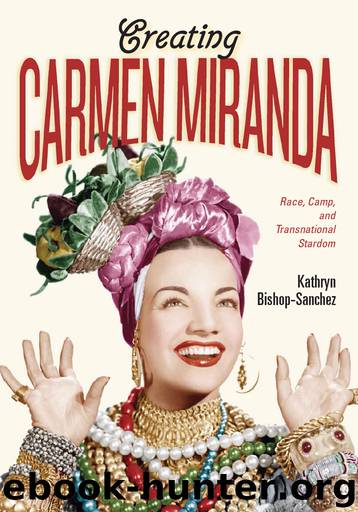Creating Carmen Miranda by Kathryn Bishop-Sanchez

Author:Kathryn Bishop-Sanchez [Bishop-Sanchez, Kathryn]
Language: eng
Format: epub
Publisher: Vanderbilt University Press
Published: 2016-12-02T16:00:00+00:00
Carmen Miranda wearing Yvonne Wood’s exquisite creation for her final number of Greenwich Village (1944). Courtesy of the Margaret Herrick Library
In Carmen Miranda’s last film for Twentieth Century-Fox, If I’m Lucky (1946), the main musical number is the “Batucada,” which despite its Latin theme was written by Josef Myrow and Edgar de Lange. Although the film is in black and white, the print contrast is well defined, and the textures of the scene’s elements are sharp and visually appealing. Miranda’s all-white costume, designed by Sascha Brastoff, gave the media much to talk about, showcasing shredded plastic on the amazing hairpiece and on the adornments at her wrists and a ruffled, highly revealing skirt with a daring slit up the front, also covered with plastic trimmings. The textured and bejeweled costume, despite its lack of the usual bright colors, creates an impression of masquerade and exquisiteness, as had become expected with Miranda’s outfits. Against this white palette, Miranda’s dark hair, long polished nails, and expressive facial features stand out in stark contrast. When the number begins, Miranda appears from behind a shimmery curtain and, as she sings, proceeds to introduce each of the native Brazilian instruments, personifying them as she goes: the cabasa with its tummy-ache, the poor old cuíca, the squared tamborim that “lets out a scream,” alongside the regô-regô and the “pandero-thing.” Striking among the costumes on the set are the peculiar, incredibly camp hats that the male instrumentalists and dancers wear, including large squared and curved oversize-brimmed sombreros, tall pointed hats, thick cylinders, and multiple spikes, whereas the girls’ black-and-white hats, equally unusual, balance an arrangement of flowers protruding from a large bow on their heads. Camp permeates the set through the costume combinations that draw their inspiration from the black-and-white, curvy sidewalk that flanks Rio’s Copacabana beachfront and that is simulated on the stage floor, creating odd, very busy striped effects extending both horizontally across the floor and vertically up through the costumes. In this scene, the limited color palette of the black-and-white contrast “spills over” to embrace differences of textures, forms, and designs and plays with contrasting vertical, horizontal, curved, and straight lines. Harry James joins the number, intermittently performing trumpet solos or singing in response to Miranda’s call to do the “Batucada, the new Brazilian jive” as a large group of dancers fills the stage. This is followed by Miranda’s reappearing on top of a kettledrum illuminated from beneath and projecting light up Miranda’s legs and open skirt, as the shimmering background curtains at the deepest part of the stage appear to go up in flames—one effect sadly lost on the black-and-white print. With both James and Miranda on symmetrically placed kettledrums, the chorines and male chorus dance around them below, forming a sea of black-and-white movement that encircles the stars. The focus is on Miranda, and the male chorines dance around her with their phallic hats, devouring her with their emasculated gaze, their bare midriffs resonating with Miranda’s costume, all in all looking effeminate
Download
This site does not store any files on its server. We only index and link to content provided by other sites. Please contact the content providers to delete copyright contents if any and email us, we'll remove relevant links or contents immediately.
| Argentina | Bolivia |
| Brazil | Chile |
| Colombia | Ecuador |
| Guyana | Paraguay |
| Peru | Suriname |
| Uruguay | Venezuela |
Cat's cradle by Kurt Vonnegut(13867)
Pimp by Iceberg Slim(12931)
Underground: A Human History of the Worlds Beneath Our Feet by Will Hunt(11257)
4 3 2 1: A Novel by Paul Auster(11049)
The Radium Girls by Kate Moore(10907)
American History Stories, Volume III (Yesterday's Classics) by Pratt Mara L(4825)
Perfect Rhythm by Jae(4621)
Wiseguy by Nicholas Pileggi(4586)
The Fire Next Time by James Baldwin(4342)
Paper Towns by Green John(4169)
A Higher Loyalty: Truth, Lies, and Leadership by James Comey(4032)
Pale Blue Dot by Carl Sagan(4001)
The Mayflower and the Pilgrims' New World by Nathaniel Philbrick(3914)
The Doomsday Machine by Daniel Ellsberg(3731)
Too Much and Not the Mood by Durga Chew-Bose(3694)
Killers of the Flower Moon: The Osage Murders and the Birth of the FBI by David Grann(3609)
The Borden Murders by Sarah Miller(3590)
The Sympathizer by Viet Thanh Nguyen(3479)
Killing England by Bill O'Reilly(3455)
